This step by step diy woodworking project is about a 20×10 outdoor gable pavilion plans. This is a large pavilion with a super wide roof that makes the perfect structure to cover a pool or a relaxation area. This pavilion features a sturdy structure with an elegant design that is suitable for any backyard. Take a look over the rest of our woodworking plans, if you want to get more building inspiration.
When buying the lumber, you should select the planks with great care, making sure they are straight and without any visible flaws (cracks, knots, twists, decay). Investing in cedar or other weather resistant lumber is a good idea, as it will pay off on the long run. Use a spirit level to plumb and align the components, before inserting the galvanized screws, otherwise the project won’t have a symmetrical look. If you have all the materials and tools required for the project, you could get the job done in about a day.
Projects made from these plans
20×10 Gable Gazebo – Free DIY Plans

Building-a-20×10-pavilion
Materials
- A – 6 pieces of 6×6 lumber – 96″ long POSTS
- B – 2 pieces of 6×8 lumber – 20 ft long TOP PLATES
- C – 2 pieces of 6×8 lumber – 152″ long CROSSBEAMS
- D – 8 pieces of 6×6 lumber – 42 1/2″ long BRACES
- E – 2 pieces of 6×6 lumber – 51 1/2″ long TOP RIDGE SUPPORTS
- F – 1 piece of 6×8 lumber – 152″ long TOP RIDGE
- G – 2 pieces of 6×6 lumber – 48″ long BRACES
- H – 16 pieces of 2×6 lumber 156″ long RAFTERS
- I – 4 pieces of 1/2″ plywood 48″x88″ long, 2 pieces – 48″x95 1/4″ long, 4 pieces – 48″x64″ long, 2 pieces – 48″x16 3/4″, 2 pieces – 48″x40″, 2 pieces – 9″x95 1/4″, 2 pieces – 9″x40″, 2 pieces – 9″x16 3/4″, ROOF SHEETS
- J – 4 pieces of 1×8 lumber 157 3/4″ long, 2 pieces – 152″ long TRIMS
- L – 4 pieces of 2×6 lumber – 53 1/2″ long DECORATIVE ELEMENTS
Tools
![]() Hammer, Tape measure, Framing square, Level
Hammer, Tape measure, Framing square, Level
![]() Miter saw, Drill machinery, Screwdriver, Sander
Miter saw, Drill machinery, Screwdriver, Sander
Time
Related
How to build a 20×10 simple gazebo
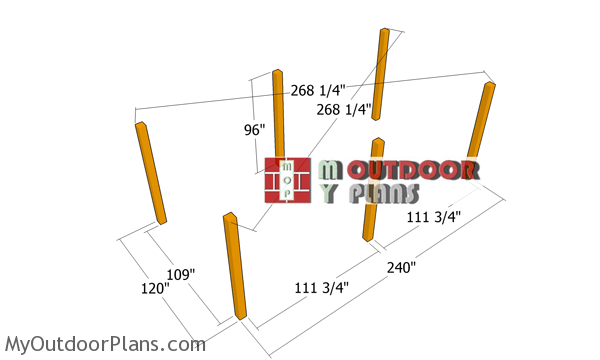
Laying-out-the-posts-for-gazebo
First, layout the posts for the 20×10 pavilion. Use batter boards and string to determine the location of the posts. Apply the 3-4-5 rule to every corner of the pavilion, so you make sure they are right angled. Make sure the diagonals are equal. Determining the location for the pavilion is essential, as you have to comply with the local building codes. Make sure the surface is level and remove the vegetation layer.
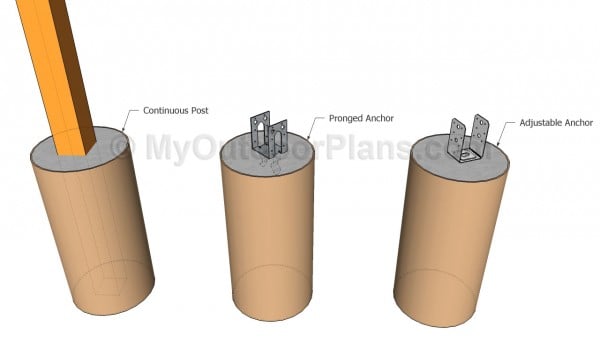
Anchoring the posts of the anchor
Level the surface with attention. Remove the vegetation layer, as well. Dig 3′ deep holes and 16″ in diameter into the ground with a post hole digger. Align the holes with attention and then fit form tubes. Fit the 6×6 posts with attention and align them using string. Use a spirit level to plumb the posts and then lock them into place with temporarily braces. Fill the tube forms with concrete and let it dry out for a few days.
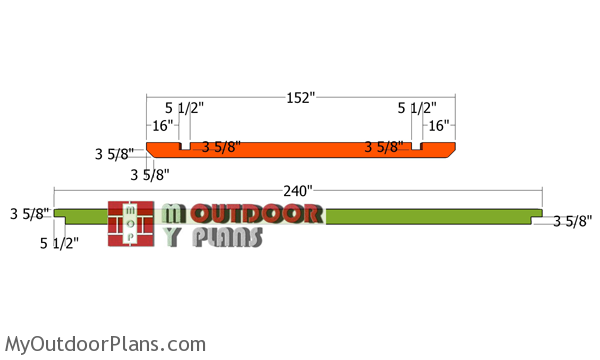
Top-beams-for-large-pavilion
Use 6×8 lumber for the top rails and for the ridge beams. Mark the cut lines on the beams and then make the cut outs with a circular saw and a chisel. Set the circular saw at 3 5/8″ and then make parallel cuts inside the marked areas. Clean the recess with a chisel and sandpaper.
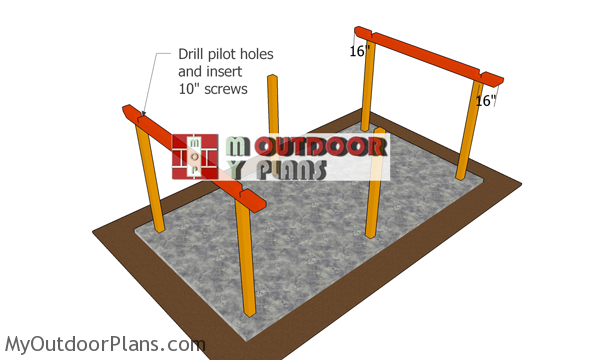
Fitting-the-side-top-plates
Fit the top rails to the sides of the pavilion. Notice the 16″ overhangs to the front and back of the pavilion. Drill pilot holes through the plates and insert 10″ screws to lock them to the posts. Use 2 screws for each joint. Make sure the corners are square and plumb the posts vertically.
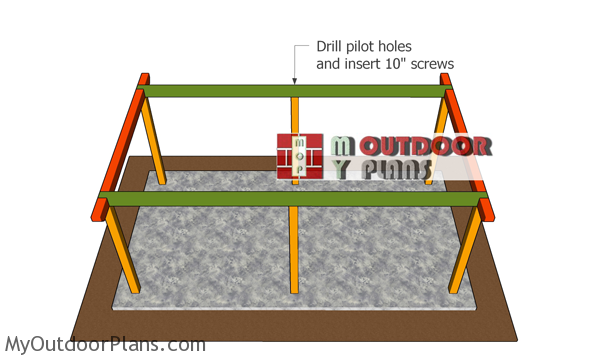
Top-beams-for-pavilion
Fit the cross plates to the pavilion. Align the edges flush and drill pilot holes. Insert the 10″ screws to lock the cross plates into place tightly.
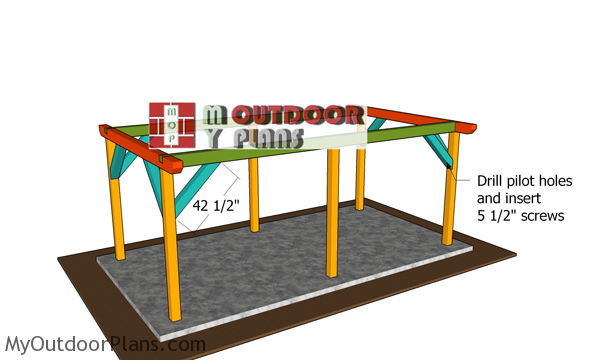
Fitting-the-braces-to-frame
Build the braces for the base of the pavilion from 6×6 lumber. Use a miter saw to make 45 degree cuts to both ends of the braces. Fit the braces to the posts, after you plumb them vertically. Drill pilot holes and insert 5 1/2″ screws to secure the braces into place tightly (2 for each joint).

Fitting-the-ridge-beam-supports
Center the 6×6 supports to the top of pavilion. Plumb the supports with a spirit level. Use post to beam connectors to secure the supports to the frame of the pavilion.
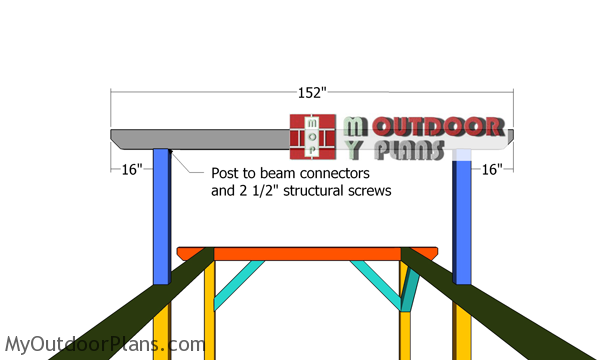
Fitting-the-ridge-beam
Fit the ridge beam to the supports with post to beam connectors. Make sure the corners are square. Use 2 1/2″ structural screws to lock the connectors into place.
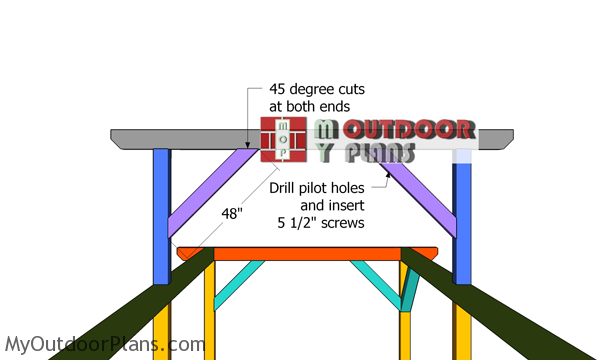
Fitting-the-ridge-beam-braces
Use 6×6 lumber for the braces. Make 45 degree cuts at both ends of the braces. Secure the braces into place with 5 1/2″ screws. Drill pilot holes before inserting the screws.

Use 2×6 lumber for the rafters. Use a miter saw to make the cuts to the boards. Smooth the edges with sandpaper. Make the notches to the rafters, as shown in the plans. Mark the lines before doing the cuts.
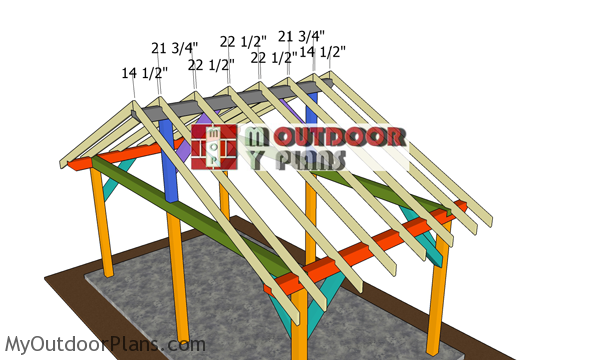
Fitting-the-rafters—20×10-gazebo
Fit the rafters to the top of the pavilion, using the information from the diagram. It is important to space the rafters properly (every 24″ on center), otherwise you won’t be able to attach the roofing sheets. Use rafters ties to lock the rafters to the beams. Use 1 1/2″ structural screws for the rafter ties.
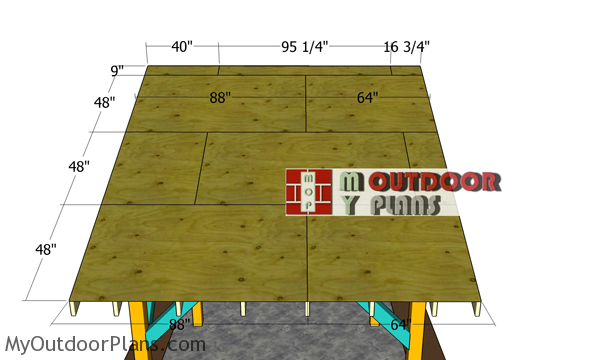
Fitting-the-roof-sheets
Use 1/2″ plywood for the roof of the pavilion. Cut the sheets at the right dimensions and then lay them to the top of the pavilion. Leave no gaps between the sheets and then insert 1 5/8″ screws, every 8″ along the rafters, so you can secure them into place tightly.
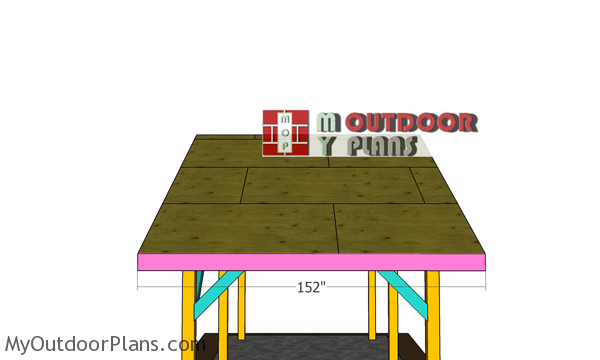
Fitting-the-side-roof-trims
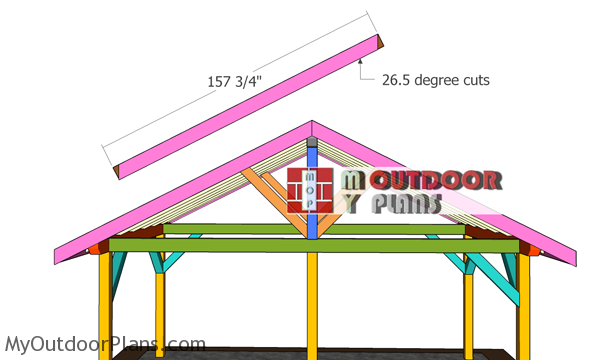
Gable-roof-trims—gazebo
Fit 1×8 trims to the sides of the pavilion. Align the edges with attention and insert 2″ nails to lock them into place tightly. Fit the 1×8 trims to the front and back of the pavilion. Lock them into place with 2″ nails.
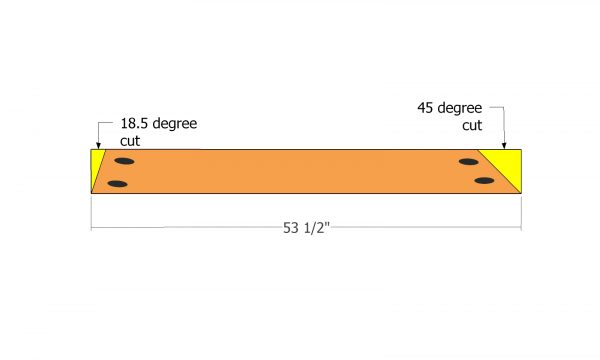
Diagonal element
Use 2×6 lumber for the diagonal elements. Use a miter saw to make the angle cuts as shown in the diagram. Drill pocket holes at both ends of the components.
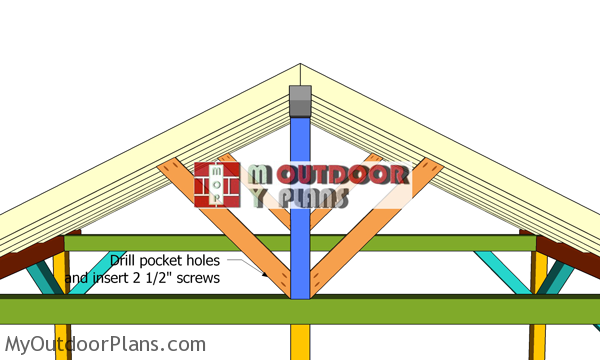
Fitting-the-diagonal-trims-for-gable-roof
Fit the elements to the three support beams and lock them into place with 2 1/2″ screws. Make sure you place the pocket holes oriented towards the inside, for a nice finish. I show them oriented towards the outside just to be clear on how they are connected to the pavilion frame.

20×10-gable-pavilion-plans—assembled
Cover the roof with tar paper and then install the asphalt shingles. Make sure you also install the appropriate drip edges, so you can seal the shed roof. Read the manufacturer’s instructions for a tight fit.
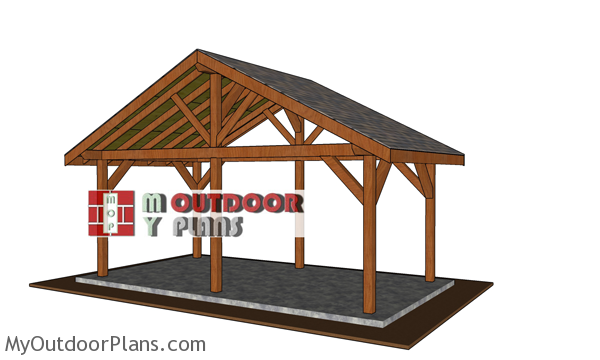
How-to-build-a-20×10-pavilion-with-gable-roof

20×10-pavilion—side-view
Last but not least, you need to take care of the finishing touches. Therefore, fill the holes with wood putty and then smooth the surface with 120-220 grit sandpaper.
Top Tip: Apply a few coats of paint or stain to the components, to enhance the look of the project. See all my woodworking plans, sorted by category. If you want to get PREMIUM PLANS for this project, in a PDF format, please press GET PDF PLANS button bellow. Thank you for the support.
This woodworking project was about 20×10 outdoor gable pavilion plans free. If you want to see more outdoor plans, check out the rest of our step by step projects and follow the instructions to obtain a professional result.

